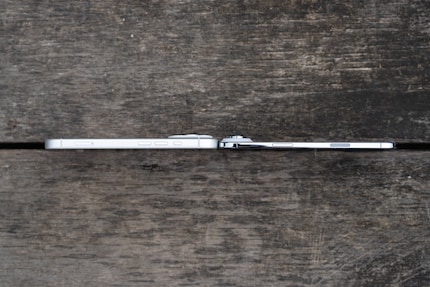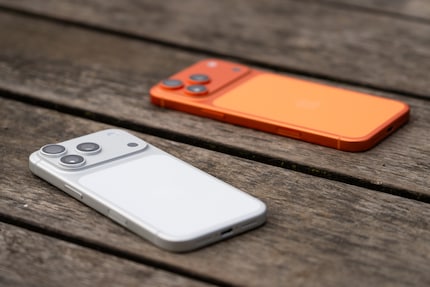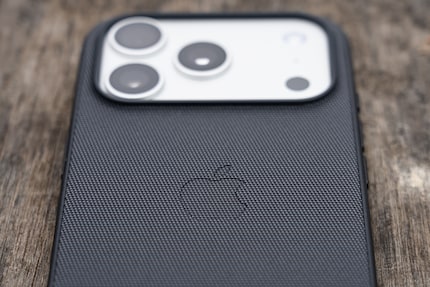
Product test
The iPhone 16 Pro affords you an unusual level of freedom
by Samuel Buchmann

Longer runtime, better cameras, cooler look. The iPhone 17 Pro may not represent an extraordinary update, but it’s still a good one. In fact, the phone’s biggest problem is its little brother.
The iPhone 17 Pro is the antithesis to the new iPhone Air. While the super-slim Air prioritises form over function, the Pro focuses on tangible improvements, including a bigger battery, better cameras and better performance. No compromises, no gimmicks, no AI bells and whistles.
Apple’s decision to differentiate more starkly between the regular iPhone, the Air and the Pro is probably a smart move. In doing so, the company’s offering a slightly more varied selection of handsets for different target groups. The iPhone 17 offers the best value for money. If beauty and prestige matter more to you than your wallet, then the Air’s your best bet.

And the iPhone 17 Pro? It focuses on maximum performance. Although the Pro case is half a millimetre thicker, this does give the device more staying power. Meanwhile, marketing mumbo-jumbo about the stability of titanium has been traded in for an aluminium unibody that dissipates heat better. While it only has a 4x telephoto camera instead of a 5x, it does come with a larger sensor. My nerd heart is filled with glee over that. The only question is, are all these upgrades noticeable in day-to-day life?
The new design is right up my street. Rather than being fancy, it has more of a tool vibe. The era of sharp edges is over, with the iPhone 17 Pro’s release finally bringing back rounded corners. It’s the first iPhone in a long time that I’d prefer to use without a case. The fact it’s half a millimetre thicker than the iPhone 16 Pro doesn’t bother me at all. Plus, I really like the combination of the aluminium unibody and matt glass on the back. Since the glass doesn’t extend to the corners – and since it’s made of Ceramic Shield – the screen supposedly ends up with fewer spider web-style cracks.

In using anodised aluminium for the housing, Apple’s opened up the possibility of using bright colours that weren’t possible with titanium. Nothing demonstrates this more than Cosmic Orange, which, to be honest, I think is utterly terrible. Deep Blue is okay. However, this year’s real star colour is the one I’ve been choosing for all my Apple products over the past few years: silver. It doesn’t reveal any scratches or fingerprints.
The front of the phone is made of Ceramic Shield 2, glass that Apple claims is three times more scratch-resistant than previous displays. YouTuber Zack Nelson confirmed the Pro’s resilience in a very satisfying durability test. As someone who uses their iPhone without protective glass, this is a really welcome upgrade. Especially since my previous handsets always ended up with little scratches on the display after a while. The Pro loses potential bonus points for scratch resistance because of the camera plateau’s scratch-prone edge.
There’s also good news on the fabric cover front. Apple’s learned its lesson from the fiasco surrounding its FineWoven material released two years ago. Its second attempt, TechWoven, looks much more robust and still appears brand new after just under two weeks of use. The coarse material fits in with the Pro’s nerdy new identity and the buttons feel just as good as they do without a case.

The iPhone 17 Pro’s camera system boasts two hardware enhancements and a software upgrade we didn’t see on its predecessor.
The Pro sets itself apart from the regular iPhone 17 as a result of its main sensor size and extra telephoto camera. The wide-angle camera, which the iPhone Air doesn’t have, is identical to that of the base model. By contrast, the new selfie camera’s available on all three of the new handsets.
The new selfie camera might seem trivial at first, but when I look back on this phone in a few years, it might just be the upgrade I remember best. First off, many of my favourite photos are selfies I’ve taken with partners and friends, so any improvement in image quality is a win.
Secondly, I think the square sensor is a brilliant idea. Since you don’t have to rotate the phone and find a good hand position to take your snaps, it allows you to switch between portrait and landscape selfies way faster. I’m even pleased to see how well automatic AI alignment works. It detects whether there’s more than one person in the frame, then adjusts the format and zoom accordingly. If it gets things wrong, you can easily override it or turn it off completely.

I was expecting more from the new telephoto camera. In order to see any difference, I need to do some pixel-peeping on super-enlarged image crops. Even so, the telephoto camera represents progress overall as it’s more versatile. Sometimes, a 100-millimetre focal length is more suitable than the old 120-millimetre one. However, in situations when you really do want the stronger zoom, the digital crop looks just as good as a native 120-millimetre image taken by the iPhone 16 Pro.

Apple also talks about the Pro’s additional 8x «optical-quality» zoom (200 mm). In my view, that’s pushing it a bit, as it’s misleading advertising. The iPhone 17 Pro simply doesn’t have a 200-millimetre lens. In reality, it’s a setting stemming from the digital zoom on the 100-millimetre camera. As a result, the photos only have 12 megapixels. The only difference between them and a simple Photoshop crop is Apple’s image pipeline, which gets a little bit more out of the picture. Mind you, I’m talking about subtle differences here – definitely not «optical-quality» zoom.

One positive that struck me is the improvement in the wide-angle camera’s image quality, although the specifications don’t indicate any change there. I don’t know if my version of the iPhone 16 Pro just happened to have a poor lens, but my iPhone 17 Pro is noticeably sharper, both in RAW format and HEIC. That said, it might also be due to improved internal image processing. Another plus point in my book is the fact that HEICs are now saved in the wide-angle camera with a resolution of 24 megapixels. For some unknown reason, the previous model only went with 12 megapixels, despite the 48-megapixel sensor.

I don’t notice any difference whatsoever between the iPhone 17 Pro’s main camera and that of the iPhone 16 Pro. With its larger sensor, it still delivers the best image quality by miles. I don’t notice any impact made by the digital 2x zoom’s supposedly improved image pipeline. And no, the zoom’s anything but «optical-quality». Even so, the main camera’s 12-megapixel crop still works really well in most scenarios.
Apple seems to have tweaked every camera’s colours and contrast. Both RAW images and HEICs are a bit warmer and have slightly darker shadows. Although I like both of these changes, neither of them are that important. In RAW format, you can adjust both anyway. What’s more, since Photographic Styles were introduced last year, you can very easily do it in HEIC format too.
The Camera Control button is still too complicated for me. Whenever I activate the touch function to adjust various parameters, I accidentally change them way too often. Apple seems to have become aware of this too. When you set up your iPhone, you’re now explicitly asked to choose between using touch controls and the Camera Button for opening the camera app and taking photos. Before, you specifically had to go into your settings to make that choice.
When it comes to video quality, Apple’s Pro model is still the gold standard. I’m always amazed at how good the recordings taken by the main camera look. If I shoot in log profile, I can easily mix them with videos from my big Sony camera. This year, I even have the option to do it in ProRes RAW format. The thing is, it takes up a massive amount of storage, so I’d definitely have to save the data onto an external SSD. Personally, I find the new dual-capture feature, which allows you to record video with the front and rear cameras simultaneously, much more useful. I’m sure the feature will be hugely popular on TikTok and Instagram.
Benchmarks and thermal images confirm the iPhone 17 Pro’s faster and better at cooling than its predecessor. The A19 Pro scores a whopping 41 per cent higher in GPU performance (check out the first slide in the graphic below), nine per cent higher in CPU performance (second slide) and nine per cent higher in AI performance (fourth slide). Plus, the housing doesn’t get as hot under load, as it can distribute and dissipate heat more evenly.
The nerd in me thinks that’s brilliant, but the pragmatist in me is unsure if users would notice this in their everyday life. I don’t play games on my smartphone, but if you do, you’ll get higher frame rates with the iPhone 17 Pro. You’ll probably also be able to enjoy it for longer, as even years down the line, new games will most likely still run smoothly on it. However, most people probably won’t be that bothered about this. The A19 Pro feels like it was made for AI features that are supposed to be out already. Alas, Apple’s new Siri is still keeping us waiting.

As things stand today, the A19 Pro’s main advantage is probably its improved efficiency, which may well contribute to lengthening battery life. Then again, it’s hard to say for sure. As well as the new SoC, Apple has fitted the 17 Pro with a new in-house wireless chip (N1) that uses less energy for the same tasks than the old one. Plus, the battery’s larger. The jump between the iPhone 16 Pro and the 17 Pro isn’t as significant in Europe as it is in the US, as European handsets still have a physical SIM card slot. However, even on this side of the pond, battery capacity has increased by 11 per cent in the Pro and three per cent in the Pro Max.
All of these factors have resulted in the iPhone 17 Pro being blessed with excellent runtime. Even with a SIM card, the new Pro beats last year’s Pro Max in various tests. In day-to-day life, this means that even under heavy use, the battery easily lasts all day. On one weekend, when I barely touched my phone, I didn’t need to charge it until two evenings in.
If you have the right charger, you’ll be able to power the phone at a maximum of 60 watts. However, the iPhone 17 Pro only briefly reaches this maximum and only does so at a low battery level. After that, it takes in less electricity. It needs 22 minutes to phone from zero to 50 per cent battery, and 78 minutes for a 100-per-cent charge. If I forget to charge it overnight and only have a few per cent left in the morning, plugging it in for half an hour gets me through the day.
The 17 Pro’s speakers, microphones, and reception are just as good as the 16 Pro’s. I personally don’t notice any difference. The display has a variable refresh rate, ranging between 1 and 120 hertz. Meanwhile, the maximum brightness has increased from 2,000 nits to 3,000 nits – but only when the sensors detect direct sunlight. Indoors, the display’s limited to 1,000 nits. If you want to give your eyes a break at night, you can really lower the brightness with Reduce White Point. You can activate this in your settings under Accessibility and add it to the Control Centre.

The improvements made to the iPhone 17 Pro initially come off as boring. And honestly, they are. However, it’s precisely these boring little enhancements that make a big impact on your day-to-day life. Certainly a bigger impact than shoehorned-in AI features or forays into extravagant design. With this in mind, I really appreciate Apple’s focus on the bare necessities.
Its new flagship handset lasts longer, has a slightly better telephoto camera and boasts an innovative new selfie camera. In my opinion, it also looks and feels good. If you’re planning on using the iPhone 17 Pro for something requiring real power, you’ll also find it’s faster than its predecessors. However, most people probably won’t notice that difference.
The iPhone 17 Pro’s biggest problem is the iPhone 17. Although the performance gap between base and Pro models is shrinking, the price difference is actually widening. The base model costs just 799 francs or 949 euros, even though its memory capacity’s been upped from 128 gigabytes to 256. Meanwhile, the Pro’s been given that same memory upgrade, but is getting increasingly expensive. It now starts at a minimum of 1,099 francs or 1,299 euros. Which begs the question: do you think the telephoto camera and longer battery life are really worth an extra 300 francs or 350 euros? If so, you’ll be happy with the iPhone 17 Pro. Although no earth-shattering changes have been made to the device, it’s still better than everything that’s come before.
Pro
Contra
My fingerprint often changes so drastically that my MacBook doesn't recognise it anymore. The reason? If I'm not clinging to a monitor or camera, I'm probably clinging to a rockface by the tips of my fingers.